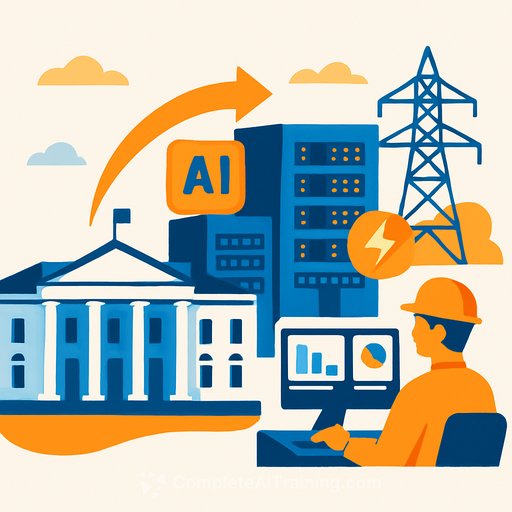Watt's Next? A Strategic Opportunity for Data Center and Energy Infrastructure Development
On July 23, 2025, the White House issued Executive Order No. 14318 to accelerate the development of artificial intelligence (AI) data centers and the critical energy infrastructure needed to support them. This order aims to fast-track federal permitting and remove regulatory obstacles that slow down the construction of AI data centers, transmission lines, and related infrastructure.
The Commerce Department, in partnership with the Office of Science and Technology Policy (OSTP), is tasked with allocating funds to encourage projects that meet specific criteria. This move is part of a broader AI Action Plan designed to boost the U.S. AI technology sector by streamlining regulations and promoting American technology exports.
What Qualifies as a Project?
The order targets two main types of projects:
- AI data centers that require more than 100 MW of new load dedicated to AI activities like training, inference, or simulation.
- Supporting projects essential to the operation of AI data centers, such as materials, products, or infrastructure.
To qualify for the expedited process, projects must meet at least one of these thresholds:
- Capital expenditures of at least $500 million.
- Protection of national security.
- Designation as a qualifying project by the Secretaries of Defense, Interior, Commerce, or Energy.
Focus on Energy Infrastructure
The order emphasizes the importance of dispatchable baseload energy sources to support AI data centers. It excludes intermittent renewable generation technologies from expedited treatment but promotes the development of transmission systems, natural gas pipelines, substations, and power generation equipment like natural gas turbines, coal, nuclear, and geothermal power plants.
Covered components also include semiconductors, networking equipment, and data storage hardware and software critical to AI operations. Notably, while the order excludes intermittent renewables from fast-tracking, the infrastructure improvements will indirectly benefit all energy sources, including wind and solar.
Streamlined Permitting Process
Key federal agencies—including the Departments of the Interior, Energy, Commerce, and Environmental Protection—are directed to revise and expedite environmental and construction permitting. Within 10 days of the order, agencies must identify existing Categorical Exclusions under the National Environmental Policy Act (NEPA) that can ease project approvals.
The Environmental Protection Agency (EPA) is tasked with updating regulations under the Clean Air Act, Toxic Substances Control Act, and other relevant laws to speed up permitting. It will also identify Brownfield and Superfund sites suitable for redevelopment, opening new opportunities to reuse contaminated land.
Departments of Interior, Defense, and Energy will identify federal lands suitable for AI data centers and related power infrastructure. They will also conduct programmatic consultations under the Endangered Species Act to streamline construction approvals over the next decade.
Water quality regulations will be reassessed to facilitate project approvals, although the order does not address water quantity needs, which remain a critical consideration for data center operations.
Additional Coordination Through FAST-41
The order references the Fixing America’s Surface Transportation Act (FAST Act), which streamlines permitting for infrastructure projects. Qualifying projects will be designated as “transparency projects,” allowing developers to opt into an expedited permitting process under FAST-41, speeding up project delivery.
Financial Incentives to Support Growth
The Commerce Department and OSTP will explore financial incentives such as tax breaks, loans, grants, and offtake agreements to support qualifying projects. This approach mirrors incentives provided for renewable energy under the Inflation Reduction Act of 2022, signaling strong government support for AI infrastructure investment.
Balancing Renewable Energy Goals
While promoting data center infrastructure, the order’s focus on dispatchable baseload energy may seem at odds with some tax credit reductions for renewables under recent legislation. However, the infrastructure improvements could ultimately help AI data centers access both renewable and conventional energy sources.
Looking Ahead: Opportunities for Executives and Investors
This executive order marks a significant shift in federal support for AI infrastructure projects by easing permitting and encouraging investment. Companies and investors that act now can benefit from less bureaucratic friction and increased access to federal lands for data center development.
The Department of Energy has already selected four federal sites for new data center and power generation projects: Idaho National Laboratory, Oak Ridge Reservation, Paducah Gaseous Diffusion Plant, and Savannah River Site.
Leaders in strategy and operations should monitor these developments closely and consider how to align their projects with the criteria to qualify for expedited treatment.
For those interested in expanding their knowledge on AI technologies and infrastructure, exploring targeted training can provide a competitive edge. Resources like Complete AI Training's latest AI courses offer practical learning opportunities to stay ahead in this evolving sector.
Your membership also unlocks:






